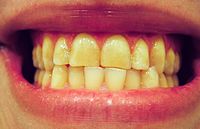
Photo from wikipedia
Temporomandibular disorders such as bruxism may cause painful clinical conditions and over time lead to chronic facial pain. A combination of therapeutic strategies that are usually undertaken by dentists and… Click to show full abstract
Temporomandibular disorders such as bruxism may cause painful clinical conditions and over time lead to chronic facial pain. A combination of therapeutic strategies that are usually undertaken by dentists and gnathologists to reduce bruxism episodes and consequently pain, are myofunctional therapy, pharmacological treatment, intraoral interventions and behavioural treatments. The aim of this work was to understand if myofuntional therapy alone can be a useful therapy for the reduction of chronic facial pain. 24 patients, 9 male and 15 female, age ranging between 25 and 45, were treated with a myofunctional therapy for 9 month. Each patient was evaluated through a numeric pain intensity scale ranging from 0 to 10 and the number of bruxism episodes/hour per patient were also recorded; electromyographic examinations of the temporal, masseter, sternocleidomastoid and digastric muscles were performed to evaluate muscle activation. Each patient was tested before (T0) and after (T1) the treatment period. Pain intensity decreased from T0 to T1 (8.13±0.39 vs. 1.75±2.43, respectively, p<0.01). The number of bruxism episodes also significatively decreased between T0 and T1 (24 vs. 9, p<0.01). Electromyographic assessment showed a decrease in the tonic activity of the masseter muscle (T0: 1.88±0.31 vs. T1: 1.4±0.25 μV; p<0.05) and a reduction of the electric activity of the temporal and digastric muscles during serration of the mandible (T0: 167.9±19.6 μV Vs T1: 144.6+16.43 μV; p<0.05 and T0: 58.97+8.38 μV Vs T1: 52.79+7.44 μV; p<0.05, respectively). Myofunctional therapy could be used to reduce facial pain as a consequence of bruxism episodes.
Journal Title: European Journal of Translational Myology
Year Published: 2017
Link to full text (if available)
Share on Social Media: Sign Up to like & get
recommendations!